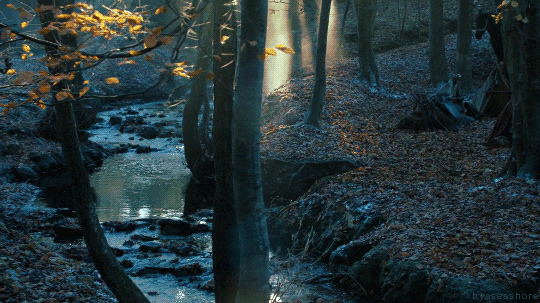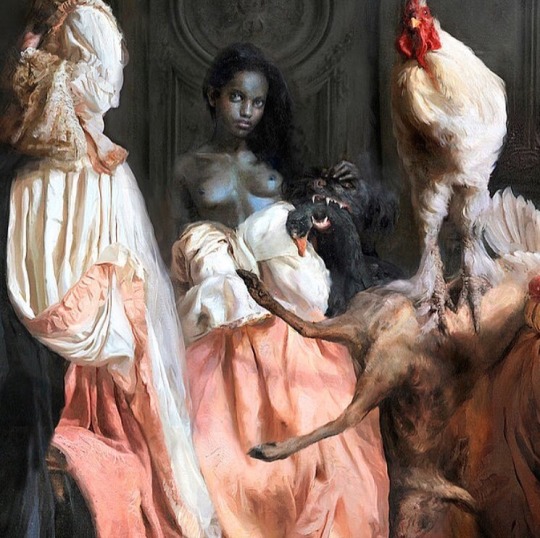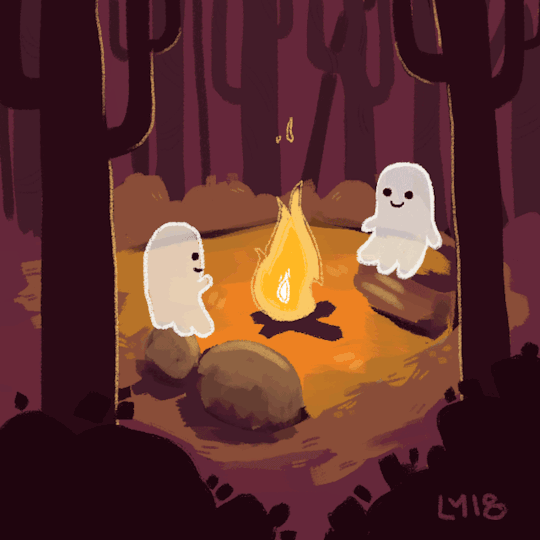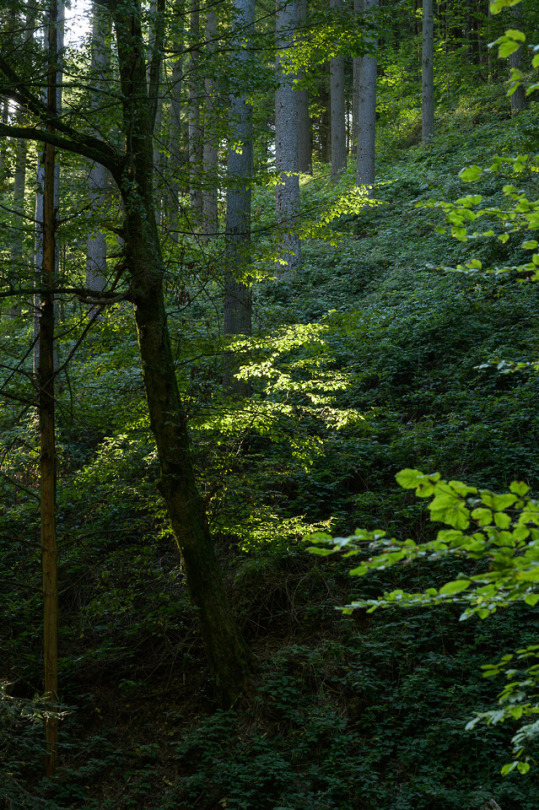♏🌞 ♐🌜 ♐🔝Afro witch, 24 years old. 6 Life Path. Eclectic/Solitary practioner
Don't wanna be here? Send us removal request.
Text
What is Animism?
This is a post taken from Sarah Anne Lawless. If you are interested in traditional witchcraft, I say you go check out her site.
“There is no environment ‘out there’ separate from us. The environment is embedded in us. We are as much a part of our surroundings as as the trees and birds and fish, the sky, water and rocks.” ~ David Suzuki
What is Animism?
The Latin animus means “the rational soul, intelligence, consciousness, and mental powers” and the feminine anima means “soul, living being, mind, and breath”. If you collect all the words for soul from all the languages around the world, almost all of their roots simply mean “breath”, insinuating that the soul and spirits in general are invisible and intangible. In the 1670s, the term anima mundi, meaning “soul of the world”, was used to describe the teachings of ancient Greek philosophers Pythagoras and Plato who believed the world and the universe itself was infused with an animate soul. In 1866, English anthropologist Sir Edward Burnett Taylor popularized the already existing term animism from the Latin anima combined with the suffix -ism (attached to words associated with practices, beliefs, doctrines, worship, etc). He defined animism as the “theory of the universal animation of nature.” Animism became the go-to term for anthropologists to describe and define the beliefs of non-Christian and prehistoric indigenous peoples.
Animism is the belief that everything has a spirit and a consciousness, a soul, from the tiniest microorganism on earth to the great planets in the heavens to the whole of the universe itself. Animistic faiths usually contain a belief in rebirth & reincarnation either as another human, or an animal, tree, or star. Anything or one can be an ancestor and in a way this is true as even scientists will tell you every single thing in the universe is created from the same space dust — all matter gets recycled and reused. Spirits of place (genus loci) are thought to be either the actual soul of the land or a soul who has come to reside in a hill, stream, or grove as its guardian and benefactor. Animism is usually viewed as more primitive with polytheism being seen as more advanced (think Stone Age vs. the Roman Empire), but as many modern religious scholars have discovered there is more natural harmony and more earthly wisdom within animism than almost any world religion.
You can try to have one without the other, however, in most cultures the two go hand in hand. The Norse had their pantheon of deities as well as strong beliefs in nature spirits, ancestors, elves, giants, and trolls. The ancient Greeks had a strong underlying current of animism from personifying everything in existence as a spirit or deity and worshipping spirits of springs, rivers, hills, and forests at the same level of devotion if not moreso than their pantheon of deities with sacrifices, offerings and festivals. Anthropologists call these divisions the “low cult” (animism) and the “high cult” (polytheism), but in truth they were not divided at all. You’d be hard pressed to find a pre-Christian religion without a fully integrated combination of deities, fairy-like beings, and an ancestor cult. You’d also find it hard to find a major world religion today without traces of animism still clinging to it. Animism was never wiped out or replaced, it has been here the whole time within the persisting belief in fairies and the otherworld, the Catholic worship of saints, the reverence and superstition surrounding trees, and our cultural folk songs and folk tales. The initial instinct of early folklorists and modern Pagans was to label it all as Paganism, but it was the survival of animism all along.
The synonym for animism we’ve been looking for within the Pagan worldview is the fairy-faith and the explanation for the fairy-faith the academic world has been seeking can be found in the animistic cults of ancestor worship and nature spirit worship throughout the world and human history.
If a religion has an ancestor cult within it or a belief in fairy-like beings, it’s a strong sign it evolved from an earlier animistic version of itself. Gods are often apotheosized celestial bodies, land spirits, animal spirits, forces of nature, and ancestors (kings, heroes, healers, and miracle workers). Deities are not separate from animism, they are born from it. The documented remnants of the fairy-faith in Ireland, Scotland, England, and Europe reveal the presence of ancient-rooted animism which was still practiced after the conversion to Christianity as is evidenced by all the many laws forbidding any practices or rites involving fairies, land spirits, and the worship of sacred stones, water, and trees. Animism is still very prevalent in African, South American, and Asiatic belief systems and folk religions today. For example, Buddhists worship the Buddha and the many bodhisattvas alongside a strong familial ancestor cult. Though the population of those practicing the recognized animistic Ainu religion is very small today, the Japanese still heavily practice Shintoism and have a seemingly irremovable belief in the yokai, or supernatural spirits, demons, and ghosts. Find an indigenous tribe in South America or Africa not yet converted to Christianity and they may not have heard of the term animism, but you can be sure their spiritual practices are intrinsically animistic with an ancestor cult.
“No religion lies in utter isolation from the rest, and the thoughts and principles of modern Christianity are attached to intellectual clues which run back through far pre-Christian ages to the very origin of human civilization, perhaps even human existence.” E.B. Taylor, Primitive Culture
Animism is not a separate faith standing on its own, it is not a capitalized “Tradition” as defined within the Pagan and witchcraft communities, and it is not a clearly defined spiritual path. Instead, animism is the seed of all religion and infiltrates all religions even in present day. Animism doesn’t exist outside of individual practice and the collective beliefs and practices of an indigenous community. Trying to define it and grasp it in a physical form (like the big name religions or smaller pagan traditions), is like trying to catch moonlight with your bare hands. I will try the best I can to attempt it, but it will only ever be my own definition, experience, and research. Animism will always shape-shift person to person, tribe to tribe, region to region.
Animism is a philosophy backed up by practice, it is a way of life and a way of thought. Animism is your personal relationship with nature and with the inhuman spirits who inhabit and compose nature. It is a relationship of respect and value for all things and all beings, visible and invisible. All life is sacred and sentient, even those outside of your current definition of life and even those regarded as malevolent. Within a balanced ecosystem, all life serves a purpose– even those who may seem like the villain at first glance. Animism is the hands-on spirit work of building an awareness of and relationship with the spirits of plants, trees, fungi, animals, insects, waters, forests, mountains, plains, deserts, elemental forces, and the spirits of the dead buried under your feet. When you live within nature you realize you are a part of it, not separate from it. It becomes important to know as much about your surroundings as possible because your survival depends on your knowledge of and respectful treatment of the land, plants, and animals around you.
The Beliefs of Animism
Within the philosophy of animism there is no distinction between magic and mundane– all is magical and all is mundane simultaneously. Consider this for a minute: every act is an act of magic. Animism lacks pretentiousness and superfluousness – if an action or item serves no real purpose then it is disregarded. In my opinion, based in research and experience, this is why the same set of rituals are found in animistic practice throughout the world. Animism is made up of shared beliefs, but moreso it is a series of practices and rituals based on these beliefs.
Common beliefs found within animism include fetishism, totemism, the belief in the soul (or multi-faceted soul) and life force, the belief in the existence of noncorporeal or supernatural spirits who can affect human lives, the belief in a spirit realm or multiple other worlds, the reverence and worship of the dead, the existence and practice of ‘witchcraft’ or ‘sorcery’ (magic used by the layperson to gain influence over or protection from spirits), and the existence of some form of shaman (witch doctor, medicine man, fairy doctor, etc) with supernatural powers and the ability to travel between realms who acts as healer and mediator between humans and spirits.
Fetishism in the anthropological sense means the belief that something seemingly inanimate can be the embodiment of a powerful supernatural spirit (anything from a statue to a tree or a mountain), or that an object can be intentionally inhabited by a spirit (a fetish like a small stone, a pocket carving, a ritual tool, a skull). Some fetishes can be very personal and never shown to another person, where only the owner or family members can look upon it and seek help or powers from the spirit within it (such as root alrauns). Other fetishes belong to the community with standing stones, Slavic god-poles, and ancient Greek crossroad herms being fitting examples.
Totemism is an ancient belief and evidence for it is most easily found in cultural folk tales of creation. Totemism is the belief in an animal, tree, river, supernatural spirit, or other animate being as the original ancestor, creator god, or teacher/benefactor of a clan or tribe and used as its symbol. This belief may be most familiar within North American Native tribes who identify as various clans or houses of the raven, eagle, wolf, etc. The indigenous Ainu in Japan and Siberia were largely a bear cult. For the animistic Hmong people of China, it is an ancient warrior ancestor named Chiyou who is revered as the founder of their tribe, but their creator god Nplooj Lwg is a frog. Each tribe has its own history, stories, songs, symbolism, and physical representations of their totem (i.e. idols, masks, and ceremonial costumes). The belief in totemism is spread further than we may realize. For example, one of my familial Scottish clans once believed they were children of the Yew tree and it has been used as their totem and symbol for longer than there is written record of. You won’t find it on the coat of arms (a modern invention), but the curious belief persisted into modern day.
Shamanism is not animism. Shamanism is a practice found within cultures with animistic belief systems. Shamans are the leaders, healers, and spirit intermediaries of their animist tribe. They have supernatural abilities that allow them to work with spirits, work against spirits, heal relationships with spirits, heal physical damage or illness caused by spirits, and the ability to travel between our physical world and the dream world, the spirit world, the world of the dead and safely back again.
Ancestor worship is another universal commonality between animistic peoples and involves the belief in the existence of the soul after death which leads to an entire cult of ancestor reverence and worship within each culture. Where ancestor veneration is found, there is also a heavy importance and reverence placed on family, tribe, and elders. Ancestor worship is tenacious and survives conversion to other religions. Catholics still have an active ancestor cult through the worship of saints and the celebrations of All Saints Day and All Souls Day. Buddhism and Shintoism both have a heavy focus on ancestor reverence and Japanese and Chinese Christians still actively practice ancestor veneration and maintain family ancestor shrines. It fascinates me that animism seems to always be bedfellows with ancestor worship. It makes sense to honour the spirits of the dead when following a practice so deeply rooted in working with spirits. It isn’t even debated in indigenous cultures, the ancestor cult is simply there alongside the people’s animism. The perfect example from Europe being the fairy-faith prevalent throughout many localities which is the combined belief in inhuman nature spirits and the spirits of the dead. Where you find the fairy-faith you find animism, and where you find animism you find ancestor worship.
The Rituals of Animism
The belief in a world full of spirits within animism leads to very specific sets of rituals with similar formulas followed across cultures. There will always be cultural differences in details and etiquette, but the ritual formulas usually contain similar steps. Before anything is done within an animist community, a ceremony is performed to ask permission of a specific set of spirits and to see if the results of the action will be favourable.
Whether you want to go hunting and foraging in the forest, fishing in a river, cut down a tree, build a new house, or ask approval of the ancestors to marry, you would first perform these steps:
Go to where the spirit(s) live (they can’t hear you if you’re not nearby).
Declare your intent aloud and request permission from the ruling spirit(s) of said place.
Submit a suitable and respectful offering to said spirit(s) and hope it is accepted.
Flatter the hell out of the spirit(s) with sweet words and songs (this can be the offering).
Ask for a specific and realistic sign of approval (the calls of animals, rain, or perform divination).
If you don’t receive the sign or something goes wrong, don’t do the thing.
If you receive the sign and everything seems sunshine and roses, go do the thing.
When you return from doing the thing successfully, thank the spirit(s) and leave a bigger offering.
Another step sometimes included is to threaten the spirit(s) which is mostly unheard of in modern Pagan and magical traditions, but very common in folk religions and animistic indigenous cultures. It has to be a good threat though and you have to know which spirits you can get away with threatening and which ones it would be incredibly disrespectful to threaten. Common threats include the withholding of offerings until a petition is granted or that you will tattle on the spirit to a fearsome boogeyman or the equivalent of the spirit’s mom or boss.
Purification & Blessing
Other common ceremonies are of purification and blessing and they will often go hand in hand with the formula above. Purification of the body and soul being performed before approaching spirits so one goes to them physically and spiritually clean as a sign of respect and also to remove any negative influences that may interfere with the petitioner’s intent. A ceremony of blessing is performed before any action is taken to help influence the best possible outcome whether the action is a journey, a marriage, a new baby, building a new house, or as simple as weaving cloth, going fishing, or cooking a meal. The Carmina Gadelica, a collection of oral incantations from Scotland from the late 1800s, is full of such rites of blessing covering everything from churning butter and blessing new livestock to waking up in the morning and going to bed at night. Despite some Catholic imagery and wording, most of the incantations are sung or recited in the hope that fairies will stay away and not mess up people’s work or daily life.
Alignment
There is no real technical term for this belief and its rites. Alignment is the practice of attempting to more closely align yourself with a spirit whether it is an animal, plant, or ancestor. This can be achieved by ingesting or smoking a plant (or rubbing on a flying ointment) during ceremony to better connect to that plant or to a greater forest spirit, crafting a fetish from an animal claw or tooth to wear to imbue oneself with the powers of said animal, or even the ancient practice of cannibalizing the dead to re-absorb their soul and power into the community. Traditional indigenous ceremonies involving costumes and masks depicting sacred animals and supernatural spirits which involve dancing and mimicking the animals and spirits are also a form of alignment which a modern Wiccan would recognize as being similar in intent to drawing down the Moon.
The philosophy is simply: the closer you are to the intended spirit and the more you work with it, the more you take on attributes and powers associated with it. The more you work with the dead and are around death, the easier it will be to commune with the dead. The more you actively work with an animal spirit, the more you will take on its positive attributes and be able to call it to your aid. Alignment also shows respect as you are consciously seeking out a relationship with spirit through actions and offerings which will likely result in reciprocation from the spirit until it becomes a familiar, ally, or helper.
The Evil Eye
Rituals that involve deflecting or counteracting the evil eye also stem from animism and its belief in the existence of intentional and unintentional sorcery by both common people or supernatural means. The belief in the evil eye is found world wide and across cultures and it can be inflicted by humans, the dead, spirits, and deities. It can be an envious neighbour sending you hateful vibes over how awesome your milking cow is or a case of elfshot caused by an angry svartálfr. The belief in the evil eye can be so prevalent and strong that an entire community will base its ethics and etiquette around avoiding the evil eye by practicing humility and the deflection of praise. It was once very common in Ireland and Scotland to shout a warning and an apology simultaneously whenever emptying the dirty washing bucket or chamber pot outside so any nearby spirits had a chance to get out of the way rather than getting splashed with filth and cursing you for being disrespectful.
Protection
It is not a common belief of animistic peoples that spirits are generally benevolent and mean us well, it is in fact the opposite. Spirits are to be appeased to prevent harm, spirits are to be kept at a safe distance, and spirits are to be protected against by any means necessary. Spirits are considered benevolent, malevolent, chaotic, or neutral with the benevolent being the rarest and usually birthed from beneficial long-term relationships between humans and spirits. The pervasiveness and endless variety of protective charms and talismans found throughout time and different cultures demonstrates how much emphasis humankind has put on the need to be protected from harm, illness, spirits, demons, ghosts, and fairies.
Protection can be in the form of a ceremony or in the form of a consecrated talisman one is meant to wear or hang in one’s home. It is painting your face white before travelling to the underworld, wrapping yourself in an animal hide before visiting the spirit world, wearing a mask or making loud, offensive noises to scare away evil spirits, the burning of bonfires on dark liminal nights, the creation of spirit traps, the burning of special herbs, or the wearing of multi-coloured clothing or mirrored clothing to deflect spirits. Animistic rites of protection can be anything from a holy person blessing someone with powers of protection in a ceremony, a talisman being crafted and consecrated to protect a person, a family or a home, to an entire community dressing up as demons and processing through the town to scare away spirits and monsters for the coming year (yes, the seasonal Krampus parades in Europe!).
A big part of protection is prevention. Animistic cultures tend to try to keep spirits away from human homes, human settlements, agricultural areas, livestock, holy places, and roads and paths. Protections are put up to keep spirits out, spirits are verbally told they are not welcome, and more respectfully, places are designated for unwanted spirits to have for themselves and have offerings left to appease them (much like how outdwellers are treated in modern Druidry). I think we can all learn about having firm boundaries from animistic practices. You don’t invite the dark fairy to Sleeping Beauty’s baby blessing, but you better make sure to send her a nice gift basket for your rudeness! Only the spirits that you trust and are known to mean you well are invited into one’s home and to a community’s ceremonies. These welcome spirits are usually restricted to the family or tribe’s totems and ancestors and even then they have very specific names they are called by to make sure the right spirits show up an no harm is caused and specific etiquette is followed so these spirits feel respected and willing to be present and bestow blessings to the people.
Comparing Animism Within Paganism & Mainstream Cultures
“Animism is a monist metaphysical stance, based upon the idea that mind and matter are not distinct and separate substances but an integrated reality, rooted in nature.” Emma Restall Orr
Is animism Paganism? Considering that members of the Pagan community can barely agree on a definition of Pagan/ism for themselves this is not a simple question to tackle. So, instead of looking at the Pagan definition of Pagan, let’s look at the world’s definition of Pagan, which, across most dictionaries and encyclopedias, is “a follower or community practicing a polytheistic religion”. Under this definition, no, animism is not synonymous with Paganism because animism is not polytheism. It does, however, include the belief in many worlds and many spirits, but not necessarily the prescribed worship of them. Sometimes the spirits may be organized into categories (such as water, earth, sky, as well as mundane and supernatural spirits), but there are no set pantheons as a Pagan would recognize. Every cult of animism is different as one tribe would most highly revere the bear as it’s main “deity” and another may most intensely focus their beliefs and rituals around one type of tree. In all honesty, a lot of traditional animistic practices involve avoiding and appeasing spirits rather than seeking them out or worshipping them. Animism is more about respect for spirits and the appeasement of spirits to prevent harm or their involvement in human affairs.
The better questions to ask are: “does Paganism stem from animism?” and “does Paganism contain elements of animism?”. The answer is yes to both. The issue we come across in attempting to cross-compare religions with animism is that most cultures in history who practiced animism had no name for it and no definition for it. It is simply the original and enduring spirituality of humankind. It’s something you do, not something you write down. Despite how ancient its beliefs and practices are, animism is a modern term derived from Latin and coming from academia. People within the Pagan and witchcraft communities have only recently started to adopt it and discuss it. Sometimes it takes us a while to find the right word to describe what we believe and do. The traditional witches and new agers all swarmed to shamanism before many figured out that it’s a hard and not so common thing to be a shaman and what they were actually doing was animism. Many contemporary or ‘core’ shamans use the term shamanism as well when many of them really mean animism. Animism is an ideal word. It is an inoffensive term, it isn’t appropriated from another culture, it doesn’t have specific dogma behind it, and anyone can use it whether they are Buddhist, Christian, Heathen, Shintoist, Wiccan, or even atheist.
Animism is not a religion. Animism is the primal foundation of all religion.
Why is there no set definition of animism in the Pagan community and why does animism feel like a newcomer when, in fact, it contains the most ancient spiritual beliefs of humankind? Because animism is not a religion and does not sit at the same table as the big theisms of monotheism, polytheism, panentheism and their kin. There are no holy books, no churches, no doctrines or dogma, and only a handful of books and articles directed to would-be practitioners coming only from a subculture niche-market within the Pagan community. The entire bulk of information on animistic belief comes from the academic study of indigenous cultures (anthropology, archaeology, ethnology, and ethnobotany), academic studies of plants and animals (botany and zoology), and mainstream culture. A good chunk of these studies pre-2000 comes from the outdated boy’s club of anthropology who did not paint indigenous cultures in a flattering light, often drawing the conclusion that animism is for the primitive, savage, less intelligent, and less knowledgeable people. They were so very wrong and animism is currently undergoing a massive mainstream resurgence with the potential to render eco-centered NeoPaganism obsolete. Modern science it leading us as a whole back to animism. The irony is perfectly glorious.
It is the tendency of the Pagan community to denigrate the mainstream and separate themselves from it. We should stop doing that. We are a part of the whole too. Whether you like it or not, you are part of the mainstream (the dictionary definition, not the negative Urban Dictionarydefinition). Animism is currently taking a much bigger foothold in the mind of the ordinary person than it ever has to Pagans. Somewhere along the line, Pagans became sidetracked and self-absorbed with the aesthetic trappings of our community and its practices and forgot about why we ended up in Paganism in the first place. Wasn’t it to find an alternative spiritual belief? One that honours the earth, nature, and our connection to spirit? When did the eco-centredness of the Paganism of the 60s and 70s dissipate? Probably at the same time the mainstream became tired with hearing the same messages about saving the earth over and over again in media and film. Why does every day Joe and every non-Pagan herbalist I’ve ever met have a better grasp of animism than the Pagan community (many of whom are unconsciously animists)? Well, when did we stop looking up from our own fantasy world to see what was going on around us? Animistic belief and philosophy is currently being fed through mainstream media to every Dick and Jane. It’s time for us to pay attention too. Animism is here, spilling over and soaking into everything and everyone like the massive spring floods inundating my county right now.
It is a good thing. This could be so important to our survival and the preservation of the earth! It’s time to stop looking solely within our tiny niche subculture and step out to look at the big picture. Never forget history is being made as we live and breathe. The changes in spiritual movements and philosophical beliefs happening right now will affect our long-term future. This is potentially a very big deal.
Animism in the Media
If you don’t believe that animism is becoming household philosophy and infiltrating mass media with absolutely no direct relation to the Pagan movement, let’s take a brief look at the news shall we? This is just the tiniest tip of the iceberg when it comes to animism in the news. Seriously, I can’t even count how many articles I found on the sentience and intelligence of plants, trees, fungi, insects, and animals, the belief in spirits, as well as the practice of ancestor worship.
1K notes
·
View notes
Text
Sun in the 12th: More creatively expressive, active and self-assured when alone and “identifies” with themselves and their own experiences as opposed to dissolving into other people, hiding away, and picking up a character that is untrue to themselves Moon in the 12th: One is aware of their own emotions and more nurturing of their own needs when alone, rather than absorbing the moods of their atmospheres and disregarding their own feelings due to a guilt complex Mercury in the 12th: Thoughts are louder but clearer when alone as well as their sense of organization rather than thoughts and opinions becoming contradictory or chaotic when around other people due to an impressionable nature Venus in the 12th: One is more affectionate with themselves, creative, as well as more indulgent of their desires when alone as opposed to being guilty of seeking out pleasure and dissolving boundaries within interpersonal relationships Mars in the 12th: Feels more motivated, stronger about convictions and less repressive of aggressive urges when alone rather than feeling weak, passive and holding onto anger or guilt Jupiter in the 12th: The sense of joy, optimism and inner fulfillment is more present when given the space to be alone; as opposed to being limited by hopelessness, criticism of what they believe in from others, and a lack of personal space Saturn in the 12th: The indvidual is more stabilized, functional and takes responsibility for shortcomings when away from the prying eyes of the public and authority figures, rather than a lack of structure/control or holding onto self-pity and denial Uranus in the 12th: Ideas and creativity are brighter and come more instantaneously when alone. One feels free, both mentally and physically when away from friends, as opposed to feeling confined or unstimulated in their daily lives, with the pressure to conform socially Neptune in the 12th: One gathers the sources of unexplained emotional pains when alone and accesses creative urges and self-compassion when alone, as opposed to disappearing and dissolving into their surroundings and feeling a vague sense of lostness among others Pluto in the 12th: A sense of self-forgiveness (as well as forgiving and helping others) and equally acknowledging strengths and weaknesses encourages empowerment and letting go of the need to control; as opposed to a cycle of self-blame and fear of being controlled by life events, figures in their lives, or simply being controlled by fear itself
1K notes
·
View notes
Text
Liminal Spaces in Witchcraft

First of all, what is a liminal space? A liminal space refers to a place or time that is in a period of transition between two phases. These are usually places where reality feels altered because you are neither moving forward or backward, like a rest stop. The word liminal originates from the Latin word limens, meaning threshold. These places often give off a sense that time stands still and that you are experiencing some sort of reality shift.
In magic and witchcraft these spaces are considered to be the boundary between our world and the other, it is known as “the in-between”. These places are considered areas of great magic because it is believed this is where the veil is thin. These places are great for divination, spirit work, meditation and astral travel; they are ideal for hedge witchcraft.
Times & Spaces of Liminality:
crossroads manmade or natural
river, creek or lake shores/ beaches
hallway/corridor/stairwells/landings/doorways
graveyards
dawn, dusk, afternoon, midnight
valleys
forest glades
many more!
Samhain/Halloween is considered the best time to communicate with spirits and faeries because of its liminality, it is a time of transition between autumn and winter. Irish folklore tells that this is the day faeries and ghosts come out to play because of the veil thinning. The equinoxes and sabbats like Beltane and Imbolc are also days of liminality because the time of day and night are equal (equinoxes) or it is a transition between seasons.
Mental states of liminality are also times of spirit communication. While being in a meditative state we are in a state of transition between our concious and sub-concious minds, this is where we sometimes experience astral projection or messages from spirits. People often experience spirit while falling asleep because this is another state of liminality.
In my craft I often practice in liminality in order to connect with the faerie realms.
-Moonlight 🌙
12K notes
·
View notes
Text
Yule Resource Masterpost

A collection of categorized links for your Yule needs! What is Yule? [X] Yule is celebrated on slightly different days depending on who you ask, but the broad spectrum is: December 20th to January 1st.
The basics:
Elements, foods, crystals and more! / Yule correspondences
Celebrating Yule
Yule: A very merry sabbat
Yule - ‘tis the season
Yule practices
50 Yuleisms
Yule Crafts:
Yule potpourri recipe
Witch balls / more witch balls
A twelve-herb sachet for Yule
Mini herb wreaths
Yule log
Yule craft ideas
Pine protection balm
Dried orange slices
Yule Recipes:
Herbal shortbread
Bread dipping oil
Chocolate yule log
Yuletide muesli
Yule tea
Yule Punch
Non-alcoholic mulled wine
Winter sabbat wine
Yule Spells:
Merry Yule jar spell / Let it snow! jar spell
Yule bath spell
Blessed Yule - For a positive holiday season
Spell for a happy family gathering
Happiness sachet for winter
Holiday home blessings
Bringing in the season
Yule Tarot Spreads:
Yule spread (3 card)
Tarot spread for Yule (3 card)
Winter solstice spread (3 card)
Yule reflection + advice spread (5 card)
A Yuletime tarot spread (6 card)
Other:
Music ideas / Yule playlist / Winter witch playlist
Altar/celebration ideas / Yule altar guide
Yule plants / Mistletoe Lore
Yule oils/incense / Yule incense
Emoji spell for a merry Yule
Spell ideas for the holidays
19K notes
·
View notes
Photo



Gorgeous, unique, hand made Labradorite smoking pipes.
Every pipe is one of a kind.
2K notes
·
View notes
Text
Praying that $1500 randomly comes to you when you need it the most this year.
297K notes
·
View notes
Text










“the magic is within us” ☪︎·̩͙ black witch aesthetics ☪︎·̩͙
5K notes
·
View notes
Text
A lesson for beginner practioners
So, before I begin, I’m not a beginner. I’ve been at this for years but I would like to show you guys something. I want to tell you a story about what it’s like being a “witch for hire.”
Now, I have a client. She’s not a bad woman, just a little ditzy but I really like her. She has supported me through my journey as a witch and I have no problem utilizing my gifts to help her completely. Well, she has problem with love. I had given her a few readings on two men but one in particular stood out. His reading was just dark, cards out here exposing him for being some evil ass demon of a man so I’m like welp. Wellll, she asked me to perform a love spell.
Before I continue, let it be known I hate love spells. I would never bash someone for performing them but as a natural lover, I think they just cause problems. However, I appreciate this client so I told her I would perform one for her. (Just because I don’t like doing them doesn’t mean I don’t do them for clients.)
So I went out and got the stuff and set it up and it just looked gorgeous. I’m talking about herbs smelling, candles glowing, energy right. Everything was good, right?
Well, one of the candles starts doing this:

I usually take this as a good sign. Flame is high which means the want is being sent out to the ancestors and they’re listening. So I go on about my business to allow the spell to let the magick flow.
Next thing I motherfucking know, the candle fucking combusts and the 7 day candle, that was pink, goes transparent and the flame goes out completely. The candle that combusts, breaks the plate it’s on and sets the desk on fire and then it’s over.

So im just sitting there looking like hell nah and I tell the client that the spell isn’t going to work because I may not have this kind of shit often but I do know that this is the result of some blockage and my ass, knowing how to Witch™️ properly tells her that I’m not going to do more. She asks me to and I’m like “yeet.”
Basically I want to tell you baby witches getting into your crafts that this is no joke. Doing spells for people is not a fucking game, it’s not cute, and it’s definitely not a guaranteed effect. Real shit happens and even things like this will leave you shaken and want to not do it anymore. You need to be in this for the long run, not for money because witches dabble with danger every single day. Practioners for hire do this every. Single. Day. And this shit is exhausting and sometimes scary and sometimes unpredictable.
@ my hoodoo practioners, stay safe and trust your ancestors because that, up there, was conjure. And if you can’t trust what your ancestors say to you (ie, combustion) then baby, this ain’t for you.
@ appropriators, you can’t handle all that up there so this is also a post reminding you to stay in your lane
@ baby witches wanting to do work for hire one day, learn protection spells first and always put your instincts first. No money is worth spiritual trauma.
4K notes
·
View notes
Text
Where to Buy Cheap Spell Supplies: Hoodoo/Brujeria Edition

i’ve seen so many resource list out there about where you can find cheap spell supplies, but their never about folk magic. I live in a very liberal place and state, but it is still difficult to find stores that sell products catered to Afro-religions or Brujeria that are affordable. Botanicas are great for staple items like oils, candles, honeys, and powders, but I wanted to make a list for more creative and specfic spells. Here’s my resource list for all my witches out there who practice folk magic, Hoodoo, or brujeria!
1. Party stores/Toy aisles at department stores: both go hand in and hand because most party stores are marketed towards children’s birthdays. Both places are a JACKPOT for spell supplies. Some things I’ve found and what I use them for include:
Toy Cop Badges: These can be used for law stay away spells, justice spells, immigration cases, and anyone you want to protect from the law or send the law for.
Toy Money: I use these for money spells to write on, burn, leave as offerings, or shred to put in mojo bags and satchets.
Dolls: Pretty self explanatory. Dolls can be used as a stand in for any person you want to influence. Cheap barbies are perfect because they are big enough to put in a lot of different positions. Speciality dolls like pregnant dolls could be used for fertility, or to protect new mothers.
Toy Phones: Need to do a lover return spell or call/text me spell? Perfect! Get yourself a toy cell phone, put it in the center of the plate, write a petition to who you want to call, put it under the phone, dress it with herbs, oils, and honey, and sugar. Put your energy into the spell for 7 days and then discard.
2. Dollar Store: The dollar store is a no brainer because everything is a dollar and if you’re trying to be a bruja on a budget, it’s a no brainer. Here are some things you can get there that you might not have thought of.
White plates, cups, bowls: White can be used for anything. You could use these dishes to put on your ancestor altar, give to your deities, or simply to do your spells on.
Fabric flowers: Perfect offerings or decorations for any altars, and if you can’t have fresh flowers or plants for any reason these are a great subsitute
Emergency candles: Most dollar stores sell something called emergency candles, usually found with the novena (religious) candles in the store. These are white, cheap, household candles that have saved me when I’m in a pinch and need to do a spell but I don’t have time to get new supplies.
Craft Aisle: You can get a bunch of helpful stuff in this aisle like jars, googley eyes (can be stuck in a jar with a petition to make someone be discovered for lying, cheating, etc) Mini plastic toy animals (can be used for all kinds of stuff. Sheep=tame sheep spells, chicken=protection spell, etc) Popsicle sticks (can be used for making crosses, building boxes, etc) Felt fabric squares (make dolls)
3. Craft Stores: Craft stores are pretty expensive and most of the main stuff you can find here you can get at a party store or dollar store with the exception of during a holiday….guys… I am a financial disaster during halloween. Some ideas include
Halloween: Bottles, jars, coffins (perfect for darker spells like “your relationship will die), toy insects (put in a jar with a doll, and herbs to cause nightmares) black candles that are CHEAP, Skulls of all shapes sizes and materials (perfect for head working spells), SO MUCH STUFF! If you guys are on a budget wait until the end of halloween and head on over to your local craft store and cash out $$$$!!
Valentines Day: A perfect time to collect all things love magic including heart shaped bottles, roses (fake or real), and chocolates for offerings.
Christmas: Theres nothing specifically around this time that I’ve found useful BUT, everything goes on sale around this time, so this is the perfect time to go ahead and pick up anything thats laying around from previous holidays.
4. Hispanic Grocery Stores: You can get some serious bulk herbs and bigger grocery stores! I buy the more obscure herbs online like fiver finger grass, but things I have found at my local Mexican grocery store include:
Mugwort: Good for psychic spells, divination, and dream work
Bulk Bay Leaves: I put bay leaves in just about everything, so I need a ton of them to sustain me and i usually get them here.
Alum Stone: Used in shut up or tapa boca spells to pucker someone’s mouth and shut them up.
Various Chili Peppers: I love peppers because they’re so versatile! They can be used in defensive spells like revenge spells or break up spells, but they can also be used for other things like fiery wall of protection.
Florida Water: Almost all Mexican grocery stores sell this, and its way cheaper than buying it online or from a “spiritual” supplier.
5. Thrift stores: When you go thrifting its best not have a specific thing in mind, but you can find some really unique witchy things at thrift stores for cheap. Some things I’ve found include:
Vintage perfume bottles: used on my altar
Candle holders: literally almost all of mine are from thrift stores
Altar cloths: Things like silk scarves or cool fabric could be used. All of mine are from thrift stores.
I hope this list helped you out and gave you some more ideas for spells, if you have anything you want me to write about or expand on from this post, let me know. Happy casting!
2K notes
·
View notes
Text
My (Small) List Of Herbs and Roots.
I’ve been doing some light researching, and this is what I’ve come up with.
__________________
Agrimony- Used to remove curses, break spells and divert the “evil eye”.
Allspice- Money drawing, luck, healing and success.
Aloeswood- Used to receive or upon the aid of malevolent spirits.
Althea- Attract benevolent spirits and positivity.
Angelica Root- Used for blessings, protection, and uncrossing.
Basil- Love, protection, peace, happiness.
Balm of Gilead- For blessings and mending broken relationships and friendships.
Bayberry Root- Money drawing and luck bringing.
Bay Leaves- Protection, psychic ability, healing and wisdom.
Black Candle Tobacco- Offering to spirits, success with legal matters.
Black Snake Root- Protection against evil, wards unwanted attention, love and virility.
Bloodroot- Purification, love and positive energy.
Buckeye- Luck, masculinity, sexual enhancement and success with games of chance.
Catnip- Positivity, luck, love, foreplay and sexual attraction.
Chamomile- Money, love, sleep, healing and luck.
Coltsfoot- Prosperity and luck, removes physical and mental ailments.
Diamiana- Aphrodisiac, sex magic, lust, new love and passion.
Devil’s Shoestring- Banishing, power, luck. Used to “trip up” evil and prevent it from coming your way.
Eucalyptus-Purification, warding against crossings, protection.
Hibiscus- Love, divination, lust and sweetening.
High John the Conqueror Root- Luck, money, sexual power.
Jasmine- Love, prophetic dreams and sensuality
Ladies Thumb- Bind someone to you or restrict their capabilities. Control and command.
Lavender- Chastity, love, protection, pain relief and luck.
Mojo Beans- Makes wishes and desires come true.
Mugwort- Safety, protection, aids in psychic and clairvoyant work.
Orris Root- Love, sexual attraction, marriage and luring men.
Patchouli- Love, money, lust, sex, passion, wealth and prosperity.
Rosemary- Protection, love, lust, power, mental ability, healing and purification.
Sage- Longevity, protection, banishing and wisdom. Used to clear and cleanse spaces.
Skullcap- Fidelity, money matters, and recovery from spirit work.
Valerian- Love, sleep, purification and protection. Can be used to strengthen hexes and curses.
Wormswood- Psychic power, protection, and love. Can be used in spirit work.
Yew- Raising the dead. Used in spirit work.
___________
*Some of these plants may very well be toxic or unsafe for consumption. I HIGHLY ADVISE you do further research before you attempt to brew teas or include any of these into food.*
935 notes
·
View notes
Text
Afrocentric Sigils: Adinkra

Sigils are a very popular technique across Tumblr from chaos magick, and innovative sigil designers are always coming up with new ways to create them. While sigils are easy to learn how to use and can be extremely effective, it’s another Western magical method. It left me wondering if there’s an Afrocentric alternative for us black witches, rootworkers, and conjurers!
Magical Symbols in Vodou and Hoodoo
It would be remiss not to mention some of the symbol systems already existing in Africana magical traditions. In the African traditional religion of Vodou, which has its own magical practices, the spirits/deities called lwa represent different powers, personalities, and energies that can be represented visually through veves. Veves are sometimes used by magical practitioners to call upon lwa to help with spells or rituals. The issue with using veves as a sigil alternative is that they belong to the religion of Vodou, require a sufficient knowledge of the lwa, and should not really be used without the proper training and/or necessary initiation into Vodou from a qualified Vodou practitioner.
So what about hoodoo? Many rootworkers influenced by Jewish Kabbalah and Christian ceremonial magical traditions drew inspiration from texts like the Greater and Lesser Keys of Solomon. So using Solomonic pentacles and complex magical symbols of that nature are also well within the general hoodoo repertoire. The thing is, sure that’s a genuine part of African-American folk magic, but it’s still imported from European traditions and has no connection to our ancestors outside of a colonial context.
Introducing… Adinkra Symbols!
So in the running for an Afrocentric sigil alternative that many people of African-descent can easily use and access, that leaves veves out for being part of an initiatory-only religion that requires in-person training and leaves Solomonic designs out for being Eurocentric. Hoping to fill this gap somehow, I thought about back when my fiancé got his first tattoo, which I proudly drew the design for! It was of the West African symbol called the Wawa Aba. You may have seen it on Wakandan Princess Shuri’s t-shirt, which is what got me thinking…

Look at this genius princess wearing the Wawa Aba with grace!
I researched the Wawa Aba further and discovered it’s one of dozens of Adinkra symbols, which are a part of the Ashanti and Baoules cultures of West Africa. They are used as cultural symbols and sometimes for ritual purposes too. You can find Adinkra symbols used extensively in fabric, pottery, architectural, t-shirt, and jewelry designs. Historically, special Adinkra clothes were only worn by royalty or spiritual leaders on special occasions, but nowadays Adinkra designs are mass-produced due to tourism.
Each Adinkra symbol has a rich set of meanings and associations, and many are linked to proverbs or wise sayings. They are a great alternative for Afrocentric folks who don’t want to rely solely on Western sigil techniques because these symbols have traditionally been used for magical purposes within their original cultural contexts but are safe to incorporate into your magical practice without culturally appropriating if you’re a person of African descent. (This is what I’ve gathered from my own research on Adinkra symbols, but of course, if I’m mistaken about anything, please correct me!)
Using Adinkra Symbols in Your Craft
So here’s just a few of the many Adinkra symbols you can incorporate into your magical practice as a black witch, rootworker, or any other kind of Afrocentric magic user! Please don’t use these if you aren’t a person of African descent.
Possible Ways to Use Adinkra Symbols:
- Write them on petition papers or name papers
- Carve them into the sides or on the bottom of a spell candle
- Arrange roots and herbs into the shape of a symbol
- Draw them on the lid of a spell jar
- Write them on slips of paper stuffed into a mojo bag
- Stir the surface of the water in the shape of the symbol for a spiritual bath
These are just some suggestions for how to use Adinkra symbols, but feel free to reblog with ideas of your own! I’ve included several below to help get started. All images below came from Adinkra.org, where you can find more of the symbols and their meanings.
Wawa Aba | Seed of the Wawa Tree

HARDINESS, TOUGHNESS, PERSEVERANCE
Mate Masie | “What I hear, I keep”

WISDOM, KNOWLEDGE, PRUDENCE
Okodee Mmowere | Talons of the Eagle

STRENGTH, BRAVERY, POWER
Duafe | Wooden Comb

Beauty, Glamour, Attractiveness
MMUSUYIDEE | Bad Luck Remover

Luck, Good Fortune, Prosperity
ODO NNYEW FIE KWAN | Power of Love

Love, Romance, Relationships
1K notes
·
View notes






